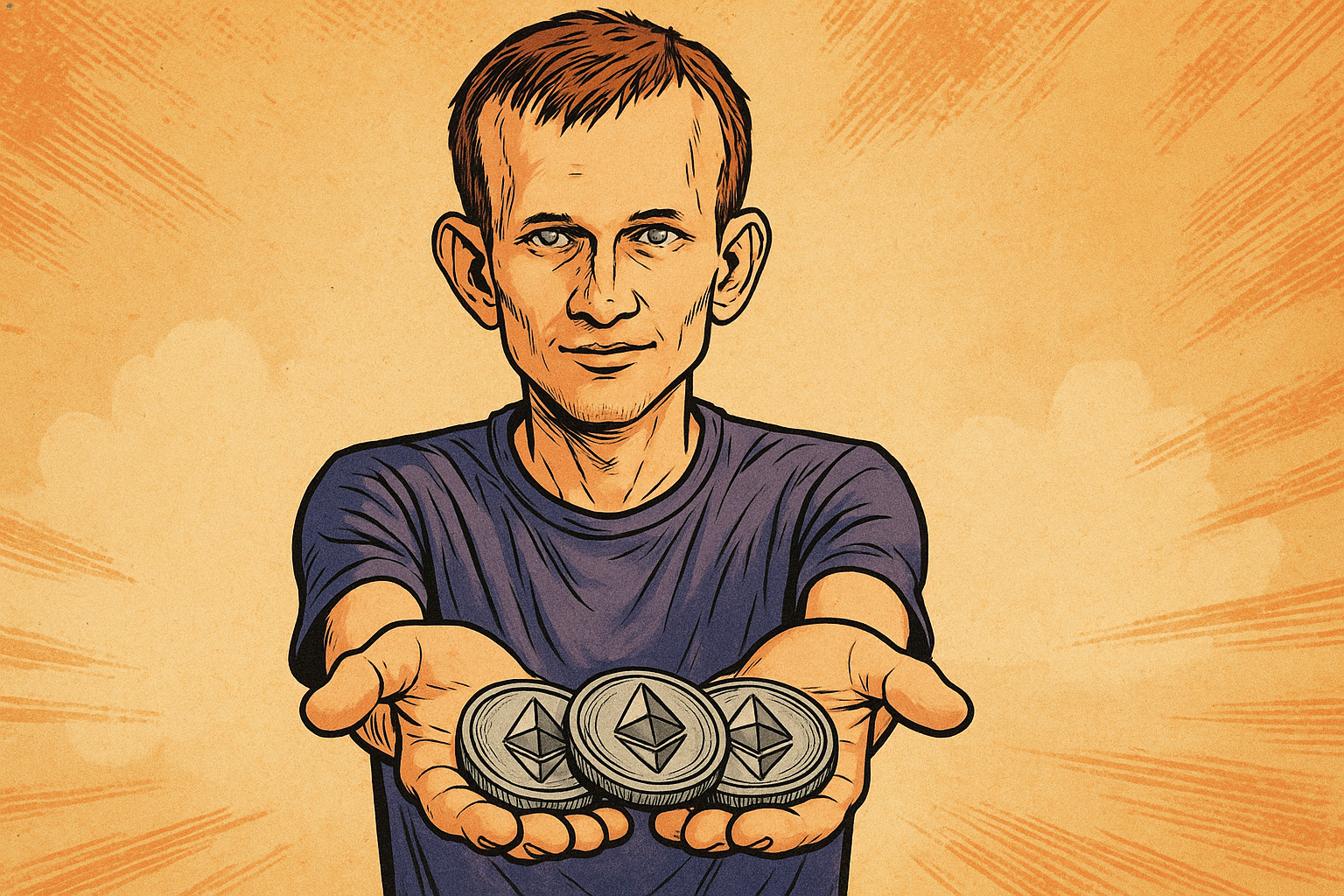Ethereum
Ethereum Still Needs VCs — says Joseph Lubin

- Share
- Tweet /data/web/virtuals/383272/virtual/www/domains/theunhashed.com/wp-content/plugins/mvp-social-buttons/mvp-social-buttons.php on line 63
https://theunhashed.com/wp-content/uploads/2025/10/lubin-1000x600.png&description=Ethereum Still Needs VCs — says Joseph Lubin', 'pinterestShare', 'width=750,height=350'); return false;" title="Pin This Post">
Why the Co‑Founder of Ethereum Thinks Value Extraction by Firms Like Paradigm Isn’t the End of the World
When you hear a founder of a major crypto network declare that “the main goal of VCs … is to suck as much value as possible from the ecosystem”, you might expect a blaze of criticism. But Joseph Lubin—co‑founder of Ethereum and the mind behind ConsenSys—says something different: yes, venture capital firms such as Paradigm may be extracting value, but they’re also needed as a bridge into the wider world of capital and infrastructure. According to Lubin’s post on X (formerly Twitter), they may not be perfect—but for now, they serve a vital role. This article explores what he said, why it matters, and how this dynamic may shape Ethereum’s future.
The Core Claim: “Value extraction” and necessity
Lubin doesn’t mince words—he writes that VCs like Paradigm aim to “suck as much value as possible from the Ethereum and broader ecosystem.” But he immediately adds that this is not a reason for panic. He argues that right now, the system still needs VCs. He frames them as the “comfortable bridge for the world’s capital to flow into our ecosystem.”
Why this framing matters: On one hand, there’s clear awareness within the Ethereum community (and crypto broadly) about tensions: decentralisation, fairness, access, and whether a few big firms dominate. On the other hand, the sheer scale of capital needed for infrastructure, research, global payments, etc., means that big money is hard to replicate purely from grassroots. Lubin’s view is that until “better, fairer, more broadly accessible on‑chain investment platforms with healthy tokenomics” emerge, these traditional VCs will continue playing a role.
What’s going on in the ecosystem
Some key developments underpin Lubin’s remarks. Notably, two Ethereum Foundation researchers left recently – one of them, Dankrad Feist, joined Tempo, a layer‑1 payments project backed by Stripe and Paradigm. The researcher movement sparked worries about centralised influence creeping into Ethereum’s open‑source, decentralised ethos.
At the same time, Paradigm’s growing presence—through hiring research staff, backing new chains, setting up new protocols—has drawn scrutiny: is it tilting the balance away from Ethereum, or influencing it disproportionately? Lubin acknowledges the concern but frames it as part of Ethereum’s “mainstreaming.” He sees this “gold‑rush of corpo‑chains” validating the idea that blockchain is entering the traditional economy.
The longer‑term vision: decentralised capital, tokenomics, infrastructure
A notable piece of Lubin’s argument is his forecast: “Very soon better, fairer, more broadly accessible on‑chain investment platforms with healthy tokenomics will mature sufficiently so that VCs will have no choice but to set up shop on these platforms.”
In other words: the present model—where big VCs lead, invest, steer—is an interim state. The future model may look more on‑chain, more distributed, with token‑based access, lower barriers. Ethereum’s broader ambition (and Lubin’s) is that infrastructure can be globally accessible, decentralised, but still tied into large pools of capital and corporate players. VCs aren’t the villain in this story—they’re part of the scaffolding while the architecture matures.
Why this matters for Ethereum and crypto strategy
For anyone tracking Ethereum, crypto governance, and capital flows, Lubin’s remarks signal a few strategic take‑aways.
Firstly, Ethereum’s path remains hybrid: a mix of decentralised protocol plus real‑world capital, corporate backing, infrastructure firms. This interplay will likely shape how upgrades, research, and ecosystem development proceed. If you’re a project builder, partner, or investor, understanding the roles of traditional VCs vs on‑chain models matters.
Secondly, tokenomics and platform economics will increasingly be battlegrounds. If different investment models are emerging—on‑chain investment platforms, tokens that give access, new funding mechanisms—then teams need to plan for those changes. It’s not just about raising VC money; it’s about how financing aligns with decentralised incentives, fair access, and governance.
Thirdly, decentralisation is still very much a goal, but the path to it may be less pure than the ideology suggests. Big firms, research talent, major capital flows—they’re part of the story. How Ethereum balances that with its decentralised ethos will determine how it evolves and how trust in the ecosystem holds up.
The risks: what to watch out for
Lubin acknowledges the concerns: centralised influence, talent drain to other chains, the potential for VCs to shape agenda or extract disproportionate value. For Ethereum and its backers, the following risks are prominent:
If VC firms become gatekeepers or insiders, they may undercut the open ethos of Ethereum. If talent flows to new chains backed by the same firms, Ethereum could lose its edge. If on‑chain investment platforms fail to materialise or scale, the reliance on VCs could entrench rather than transition.
Moreover, users and developers increasingly expect decentralisation not just in name but in practice—governance, node operation, choice of chains, interoperability. The tension between corporate‑friendly infrastructure and open protocol access will remain.
Final thoughts
Joseph Lubin’s message is a nuanced handshake between idealism and pragmatism. He accepts that VC firms aim to extract value, but he doesn’t consider that a fatal flaw—instead, he sees them as strategic partners in the current phase of development. The bigger story is the transition: toward investment models that are on‑chain, broad‑based, and aligned with decentralised token‑economics.
For the ecosystem around Ethereum, that means planning for a dual reality: today’s reality of VCs and major firms, tomorrow’s aspiration of distributed capital and more democratic access. Projects and stakeholders will need to map their strategies accordingly—leveraging current funding and infrastructure while positioning for the future shift.
Ethereum
Small Kingdom, Big Move — Bhutan Stakes $970 K of ETH via Figment to Back National Blockchain Ambitions

Bhutan Turns Heads With Institutional‑Grade ETH Stake
The government of Bhutan quietly moved 320 ETH — worth roughly $970,000 — to Figment, the well-known staking provider, signaling a major shift in how the Himalayan kingdom engages with crypto. Rather than a speculative or retail‑style buy, this is an institutional‑level stake: the amount deployed corresponds to 10 full Ethereum validators (since each validator requires 32 ETH).
More Than Just Yield: Bhutan Anchors Crypto in Governance
Bhutan’s ETH stake comes on the heels of a far broader crypto‑adoption push. In October 2025 the country launched a sovereign national digital identity system — built not on a private chain, but on the public Ethereum blockchain. The decision to anchor citizen identities on a decentralized, globally supported network like Ethereum underscores a long‑term vision: decentralized identity, on‑chain transparency, and national infrastructure built with blockchain.
For Bhutan, this ETH stake isn’t about short‑term price swings or hype — it reflects a strategic bet on Proof‑of‑Stake infrastructure. By running validators via Figment, the government contributes to network security, potentially earns rewards, and aligns its own holdings and governance systems with the protocols underlying its digital‑ID rollout.
What This Signals for Ethereum — and for Crypto Governance
Though 320 ETH is a drop in the bucket compared to total staked ETH globally, the move carries symbolic weight. A sovereign state publicly committing funds to ETH staking via a recognized institutional provider adds to the broader narrative: that Proof‑of‑Stake networks are maturing, and that blockchain can underpin more than speculative assets — it can support identity, governance, and long-term infrastructure.
Moreover, it highlights that institutional staking services like Figment are increasingly trusted not only by hedge funds or corporations, but by governments. According to Figment’s own data, their Q3 2025 validator participation rate stood at 99.9%, and they reported zero slashing events — underlining the reliability such clients are counting on.
What to Watch Next
Will Bhutan stake more ETH? On‑chain data shows the wallet still holds a portion of ETH that remains unstaked — suggesting potential for future validator additions.
Will other nations follow suit? If Bhutan’s mixed use of crypto — combining reserve assets, public‑service infrastructure, and staking — proves viable, it could serve as a blueprint for other smaller states looking to modernize governance with blockchain.
Will this affect ETH’s valuation? Hard to say immediately. The 320 ETH is unlikely to move market prices by itself. But if this step becomes part of a larger trend toward institutional and sovereign staking, the cumulative effect on demand and network security could indirectly support ETH’s long-term value proposition.
Ethereum
Vitalik Buterin’s $760K Bet on Privacy: What His Donation to Session & SimpleX Chat Signals for Crypto Messaging

The Ethereum Co-Founder’s Move Sends a Clear Message
When Vitalik Buterin committed a six-figure sum to two emerging privacy-focused messaging apps, it wasn’t just philanthropy — it was a strategic statement. Buterin donated 256 ETH, worth around $760,000, split evenly between Session and SimpleX Chat. His stated goal was to support projects pushing the boundaries of messaging privacy, especially those eliminating traditional identifiers like phone numbers and making metadata invisible.
This kind of move doesn’t happen in a vacuum. In a time when digital surveillance is tightening and governments are scrutinizing communication platforms with increasing intensity, Buterin’s gesture highlights a pivot: from just end-to-end encryption to full-stack privacy, where even metadata — who, when, how often — is protected.
Why Session and SimpleX Matter Now
Session and SimpleX represent a different paradigm from mainstream encrypted apps like Signal or Telegram. Session leverages a decentralized onion-routing network to remove central points of failure and obscure the origin and destination of messages. It doesn’t require a phone number or email to create an account, which means your communication identity isn’t linked to your real-world ID.
SimpleX Chat takes a similarly radical approach. It discards all global user identifiers and uses temporary, non-persistent session IDs. By default, it avoids any server-side storage of user metadata. This pushes the envelope on what private messaging can mean in a Web3 context.
But these aren’t just fringe apps. They represent a broader movement aiming to decouple identity from communication — something that increasingly resonates in crypto-native communities, where pseudonymity and sovereignty are core values.
More Than Encryption: The Metadata Battle
Traditional “secure messaging” has largely focused on content encryption — making sure only sender and receiver can read the messages. But in reality, metadata often tells a more powerful story. When messages were sent, how often you interact with someone, and your communication graph can all be used for behavioral profiling or even retroactive surveillance.
Buterin made clear that metadata privacy is what matters most now. Without tackling this, he argued, truly private communication cannot exist. That’s what sets his donation apart from the usual talk around encryption — it’s a direct endorsement of messaging without identifiers, without centralized relays, and without traceable networks.
This push is timely. As lawmakers in the EU and elsewhere explore so-called “chat control” proposals that would force companies to scan messages or retain metadata, the crypto space is responding by building alternatives. These aren’t just apps — they’re defensive tools for digital sovereignty.
A New Standard for Web3 Messaging
The implications for the broader crypto and Web3 landscape are significant. Messaging is the most common digital activity, and yet Web3 has largely ignored it in favor of finance and infrastructure. But with Buterin’s donation, a clear priority emerges: communication deserves the same decentralization and privacy guarantees that DeFi or NFTs claim to offer.
These apps could become part of a broader stack of decentralized identity and communication tools. Imagine wallets that message, DAOs that coordinate privately, or pseudonymous communities built on trustless comms. It’s not hard to see a future where crypto-native messaging protocols replace traditional platforms for everything from coordination to customer support.
That said, the technical challenges are steep. Delivering strong metadata privacy without sacrificing multi-device support, uptime, or usability is no easy feat. Session, for instance, still struggles with message delivery in fringe networks. SimpleX is relatively new and has yet to scale its infrastructure globally.
But if these projects succeed, they may define what Web3 communication should look like: decentralized, permissionless, and invisible to the watchers.
What Comes Next
Vitalik Buterin’s donation is a catalyst, but it also raises expectations. Privacy-focused apps like Session and SimpleX must now prove they can scale beyond early adopters. That means building user-friendly interfaces, integrating with crypto tools, and making privacy seamless — not a technical obstacle.
If these apps succeed, they could become foundational in the same way MetaMask or Uniswap did in their domains. And if others follow Buterin’s lead — both with capital and adoption — we could see a serious pivot in Web3 toward communication infrastructure that doesn’t leak our lives through metadata.
In the age of AI surveillance, mass data collection, and algorithmic profiling, who you message — not just what you say — is a liability. But with projects like Session and SimpleX now backed by Ethereum’s most influential founder, the path to invisible messaging just got a powerful new boost.
Ethereum
Offchain Labs Pushes Back on Vitalik Buterin’s RISC‑V Proposal, Says WASM Is the Smarter Path for Ethereum

In a move that could influence the next generation of blockchain architecture, Offchain Labs — the core developer behind the Arbitrum ecosystem — has publicly challenged Vitalik Buterin’s recently floated idea to adopt the RISC‑V instruction set architecture (ISA) as the foundation for Ethereum’s execution layer. The research team argues that while RISC‑V has become prominent in zero‑knowledge (ZK) proof systems, it may not be the optimal choice for smart‑contract delivery on layer one. Instead, they propose WebAssembly (WASM) as a more future‑proof format.
The Core of the Debate
Offchain Labs’ researchers introduce a useful conceptual separation: the “delivery ISA” (dISA), which defines how contracts are uploaded and stored on‑chain, versus the “proving ISA” (pISA), which is used by ZK‑VMs to verify execution. They argue that Vitalik’s proposal implicitly assumes a single ISA should serve both roles, but this assumption risks locking Ethereum into a format optimized for today’s ZK proving, not long‑term delivery and flexibility.
The team points out that RISC‑V has shown strong performance in ZK proof contexts, but it does not necessarily perform well in diverse node‑hardware environments, where most clients do not run native RISC‑V CPUs. Emulating RISC‑V on commonly used hardware introduces inefficiencies and may undermine decentralization. WASM, by contrast, executes efficiently on general hardware, is type‑safe, and benefits from a robust and well‑supported developer ecosystem.
Implications for Ethereum’s Future
The research suggests that anchoring Ethereum’s delivery ISA to RISC‑V now could effectively freeze the ecosystem into a proving‑ISA strategy that may become outdated as ZK‑VM architectures evolve. They caution that RISC‑V was never designed primarily for ZK proving or smart‑contract delivery but rather for hardware microprocessors — a fact that limits its long‑term suitability in a general‑purpose blockchain context.
By selecting WASM for contract delivery, with the option to compile it into whatever proving ISA emerges as superior, the blockchain ecosystem retains flexibility, avoids hardware lock‑in, and aligns smart‑contract deployment with a mature and widely supported programming standard. Offchain Labs argues WASM could philosophically serve as an “Internet protocol” layer for smart contracts — agnostic to the underlying hardware or proof system.
Why This Matters Right Now
Ethereum is nearing a set of protocol design decisions that will shape not just the next upgrade, but its evolution over the coming decade. As ZK proof technologies evolve and node hardware becomes increasingly heterogeneous, selecting an ISA for Layer 1 becomes a strategic architectural choice, not just a technical one. If Ethereum adopts an ISA optimized solely for today’s proving stack, it may compromise adaptability, decentralization, and inclusivity across hardware platforms.
Offchain Labs’ response reframes the ISA decision as a battle between flexibility and immediate efficiency. Their argument is simple: prioritize future‑proofing over optimization for today’s ZK tech.
What to Monitor
Over the next several months, developers and observers should keep an eye on Ethereum’s core roadmap and community discussions. Will the network choose separate ISAs for delivery and proving? Will it commit to RISC‑V or pivot to WASM? The maturity of tooling, compiler support, and infrastructure around WASM could prove decisive, especially as alternative ZK‑VM designs begin to experiment with non‑RISC architectures.
Ultimately, this may look like a low‑level implementation dispute, but it reveals something deeper: Ethereum’s infrastructure choices today will define its trajectory for the next decade. The RISC‑V vs. WASM debate is not just about smart contracts — it’s about what kind of computational future Ethereum wants to build.
-

 Cardano2 months ago
Cardano2 months agoCardano Breaks Ground in India: Trivolve Tech Launches Blockchain Forensic System on Mainnet
-

 Cardano2 months ago
Cardano2 months agoCardano Reboots: What the Foundation’s New Roadmap Means for the Blockchain Race
-

 Cardano2 days ago
Cardano2 days agoSolana co‑founder publicly backs Cardano — signaling rare cross‑chain respect after 2025 chain‑split recovery
-

 Bitcoin2 months ago
Bitcoin2 months agoQuantum Timebomb: Is Bitcoin’s Foundation About to Crack?
-

 Cardano2 months ago
Cardano2 months agoAfter the Smoke Clears: Cardano, Vouchers, and the Vindication of Charles Hoskinson
-

 Cardano2 months ago
Cardano2 months agoMidnight and Google Cloud Join Forces to Power Privacy‑First Blockchain Infrastructure
-

 Ripple2 months ago
Ripple2 months agoRipple CTO David “JoelKatz” Schwartz to Step Down by Year’s End, but Will Remain on Board
-

 News2 months ago
News2 months agoRipple’s DeFi Awakening: How mXRP Is Redefining the Role of XRP












